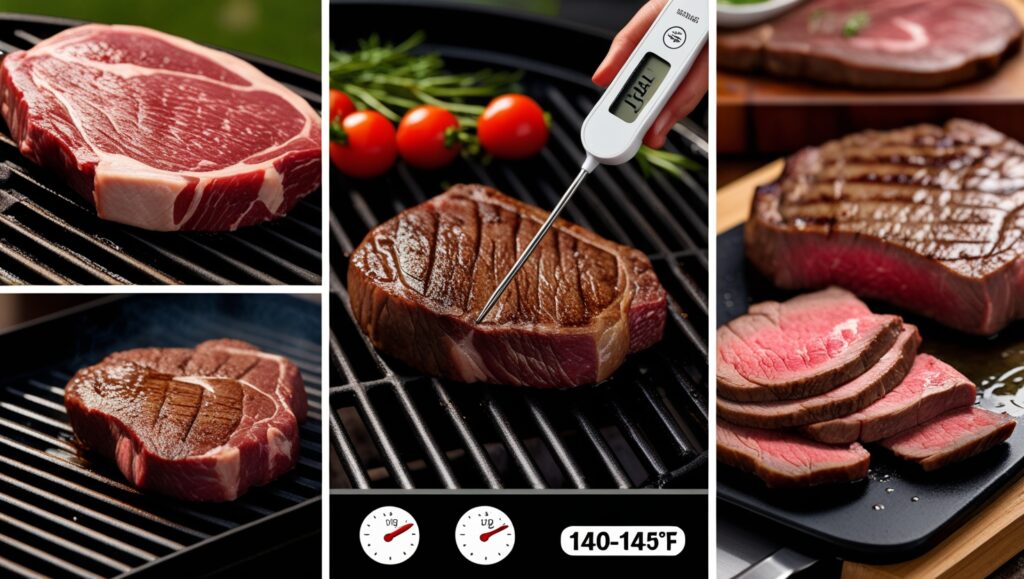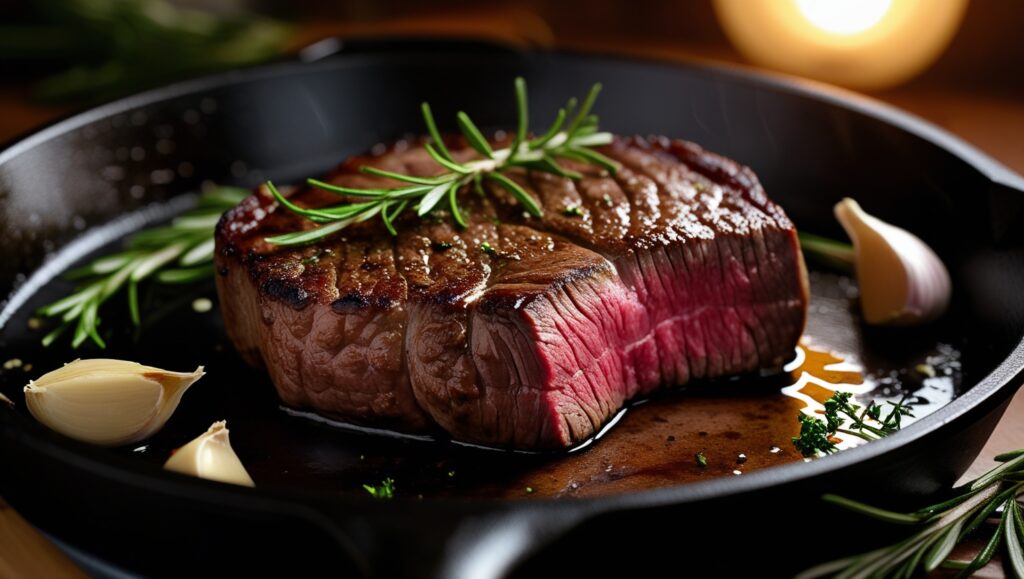There is very little success in cooking that can accommodate the satisfaction of cooking steaks in the perfect medium size. Just start to understand whether you’re an experienced house chef or get the best from steak with the best of Medium bones and increase your meal from normal to extraordinary.
This extensive guide examines all aspects of cooking media-sized steaks with the perfect media-sized size from an understanding of media-sized trains. You will also learn through common pitfalls to achieve a juicy, delicious medium sized steak consistently, and to achieve a juicy, aromatic medium sized steak every time.
What Exactly is a Medium Steak?
When you hear someone order a medium steak at a restaurant, what does that really mean? The term medium steak refers to the degree to which the steak is cooked, specifically its internal temperature and the corresponding texture and color.
A medium steak is typically cooked to an internal temperature between 140°F and 145°F (60°C to 63°C). At this temperature, the steak is:
- Warm and slightly firm throughout
- Light pink in the center, signaling it’s cooked but still juicy
- Juices clear or faintly pinkish, indicating proper moisture retention
This doneness offers a balanced experience—enough heat to develop a flavorful crust on the outside, while keeping the inside tender and moist.
Visual and Texture Guide to Medium Steak
- Color: Light pink center with a brownish outer edge
- Texture: Firm yet tender, springy to the touch
- Juices: Mostly clear with slight pink tint
Cooking a steak medium ensures it’s no longer raw or overly rare but avoids the dryness of well-done steaks.
The Science Behind Steak Doneness
Understanding the science behind steak doneness can help you achieve consistent results.
What Happens Inside the Steak?
- Protein coagulation: As heat penetrates the meat, proteins denature and coagulate, changing the texture from soft and raw to firm.
- Moisture redistribution: Heat causes juices to move from the center to the surface, which is why resting the steak is crucial.
- Maillard reaction: The high-heat searing causes a chemical reaction between amino acids and sugars, creating that delicious brown crust packed with flavor.
At medium doneness, proteins have coagulated enough for a firmer texture, but enough moisture remains inside, keeping the steak juicy.
Best Cuts of Steak for Medium Cooking
While nearly any steak can be cooked medium, some cuts respond better to this cooking level due to their marbling and muscle composition.
| Steak Cut | Description | Medium Steak Suitability |
|---|---|---|
| Ribeye | Highly marbled, rich and fatty | Excellent—fat renders perfectly |
| New York Strip | Firm, flavorful with a good fat cap | Great—balances tenderness and bite |
| Filet Mignon | Extremely tender, lean, mild flavor | Good—can dry out if overcooked |
| Sirloin | Leaner, firmer texture | Good—requires attention to avoid toughness |
| T-Bone/Porterhouse | Combines tenderloin and strip loin | Excellent—two textures in one |
| Flat Iron | Well-marbled, flavorful, moderately tender | Good—ideal for grilling |
Tip: Choose steaks that are about 1 to 1.5 inches thick. Thinner cuts cook too fast and risk overcooking; thicker cuts allow better control over doneness.
How to Properly Prepare Your Steak for Cooking
Preparation can make or break your medium steak. Here’s how to prep like a pro:
1. Bring Your Steak to Room Temperature
Cold steak straight from the fridge cooks unevenly. Allow the steak to sit out for 30-60 minutes before cooking to reach room temperature.
2. Pat Dry
Use paper towels to remove surface moisture. This helps develop a crispy sear instead of steaming.
3. Season Generously
- Salt: Use coarse kosher salt or sea salt to season both sides at least 40 minutes before cooking or immediately before searing.
- Pepper: Freshly ground black pepper adds flavor, but apply just before cooking to avoid burning.
4. Oil the Steak or Pan
Lightly brush the steak with a high smoke point oil or add oil to your pan for searing.
5. Optional Marinades or Rubs
While a classic medium steak often shines with just salt and pepper, marinades or dry rubs can add interesting flavors.
Top Cooking Methods for Medium Steak
There are multiple ways to cook a medium steak, each imparting different flavors and textures.
Grilling a Medium Steak
Steps:
- Preheat grill to high heat (around 450°F to 500°F).
- Place steak on the grill and cook for about 4-5 minutes per side (adjust based on thickness).
- Use a meat thermometer to check internal temperature (140-145°F).
- Remove steak and rest before serving.
Pro Tips:
- Use direct heat for searing, then move to indirect heat if needed to finish cooking without burning.
- Grill marks add visual appeal and caramelization.
Pan-Searing a Medium Steak
Steps:
- Heat a heavy skillet (preferably cast iron) over high heat until smoking hot.
- Add oil, then place steak in pan.
- Sear for 3-4 minutes per side, creating a deep brown crust.
- Reduce heat to medium-low and cook for an additional 1-2 minutes if needed.
- Check temperature and rest.
Pro Tips:
- Add aromatics like garlic cloves, thyme, and butter for basting during the last minute.
- Use the pan juices to drizzle over the steak after resting.

Broiling a Medium Steak
Steps:
- Preheat broiler and place oven rack about 4-6 inches from heat source.
- Place steak on a broiler pan or heavy oven-safe skillet.
- Broil for 4-6 minutes per side, closely monitoring.
- Check internal temp and rest.
Pro Tips:
- Keep the oven door slightly open to prevent overheating.
- Flip once halfway through for even cooking.
Sous Vide + Searing for Perfect Medium Steak
Sous vide is a modern technique offering precise temperature control.
Steps:
- Season steak and vacuum-seal it in a bag.
- Cook in sous vide water bath set to 140°F (60°C) for 1-2 hours.
- Remove, pat dry, then quickly sear in a hot pan for 1 minute per side.
- Rest briefly and serve.
Pro Tips:
- Sous vide guarantees perfect medium doneness throughout.
- Finish with butter basting for extra flavor.
How to Accurately Check Steak Doneness
Using the right tools and techniques ensures you get the perfect medium steak every time.
Meat Thermometer Method (Most Accurate)
- Insert thermometer probe into the thickest part of the steak.
- Look for 140°F to 145°F (60-63°C) for medium doneness.
Touch Method (Experienced Cooks)
- Press the center of the steak with your finger or tongs.
- Medium steak feels like pressing the fleshy part below your thumb when your hand is relaxed.
Visual Cues
- Slightly pink center, not red or raw.
- Juices run clear or faintly pink.
The Importance of Resting Your Medium Steak
Resting allows juices, which move toward the surface during cooking, to redistribute back into the meat fibers. This results in a juicier and more flavorful steak.
- Rest steak for 5-10 minutes loosely tented with foil.
- Cutting too soon causes juices to spill out, drying the steak.
Flavor Enhancements and Serving Suggestions
Elevate your medium steak experience with complementary sides, sauces, and garnishes.
Flavor Enhancements
- Compound butter: Mix butter with herbs, garlic, or blue cheese.
- Herb oils: Drizzle basil or rosemary-infused oil.
- Chimichurri sauce: Bright and tangy, a perfect match for steak.
- Red wine reduction: Adds richness and depth.
Perfect Side Dishes
- Garlic mashed potatoes
- Grilled asparagus or broccoli
- Roasted mushrooms
- Creamed spinach
- Fresh garden salad with vinaigrette
Common Mistakes and How to Avoid Them
| Mistake | How to Fix It |
|---|---|
| Cooking steak cold | Bring to room temp before cooking |
| Overcrowding the pan/grill | Cook steaks in batches for even heat |
| Not seasoning enough | Salt liberally before cooking |
| Skipping resting | Always rest steak 5-10 minutes after cooking |
| Using low heat for searing | Use high heat to get crust |
| Not using thermometer | Use one to avoid guesswork |
FAQs About Medium Steak
Q: Is medium steak safe to eat?
A: Yes, medium steak is cooked to a safe internal temperature that kills harmful bacteria while preserving flavor.
Q: How long does it take to cook a medium steak?
A: Depending on thickness and method, 4-6 minutes per side on high heat is typical.
Q: Can I cook a frozen steak to medium?
A: It’s better to thaw first for even cooking and accurate doneness.
Q: What if my steak is overcooked?
A: Use sauces or butter to add moisture. Next time, remove from heat sooner.
Conclusion and Final Expert Tips
Mastering the art of cooking a medium steak requires attention to detail, quality ingredients, and the right techniques. Remember to:
- Select the right cut
- Season and prep properly
- Use the best cooking method for your setup
- Monitor temperature with a thermometer
- Let your steak rest before serving
With patience and practice, you’ll be serving perfect medium steaks packed with flavor and juiciness every time you cook.
